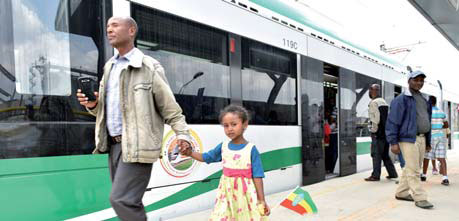New light rail changing lives in Addis Ababa
Babure is the Amharic name for the first light rail system operating in Addis Ababa, capital of Ethiopia. Starting in September, traffic in the city has been flowing more smoothly thanks to the 34-kilometer system, which intersects Haile Gebresilase Street.
China Railway Engineering Corp completed the $475 million project in three years, with services now operated by Shenzhen Metro Group Co Ltd. Eighty-five percent of the funding came from China Export-Import Bank.
According to the city government, the aim of developing modern transport infrastructure was to ease congestion and cut costs for low-income workers.
|
Local residents walk outside the first light rail built and operated by Chinese companies in Addis Ababa, capital of Ethiopia. Sun Ruibo / Xinhua |
One line, which has blue carriages, covers 16.9 km and runs north to south, serving 20 stations from Menelik to Kaliti. A second line, which has green carriages, stretches 17.4 km and runs east to west, linking Ayat to Tor Hailoch. Daily services run 6 am to 10 pm.
Mehert Endle, a young entrepreneur, says the 2.7-km stretch through the city center has more than halved his daily transport costs. Although he runs an electronics shop downtown, he says he has to travel around town picking up and delivering orders.
"I spent more than 60 birr ($2.7) a day just running errands. This is in addition to time wasted in traffic jams. Now, this is a thing of the past and I spend about 4 birr," he says, as he waits for a train to take him home to Ayat.
Endle says the journey used to take more than half an hour by minibus. It takes just 15 minutes on the train.
In addition to easing transportation, the network has also catalyzed development in downtown areas.
Getfam Hotel, a four-star establishment that faces the new rail network, opened barely a year ago.
"Most foreigners prefer rooms facing the tracks," says Dibora Ahmed, a receptionist at the hotel. "The carriages and station are beautifully lit in the evenings."
She doesn't use the light train to get to work because she lives in Satis, about an hour from downtown. But she says it has alleviated the time she spends waiting for a minibus.
"The train now takes some people who used to take the same transport as me. Now we don't need as much time waiting for the next vehicle as before," she says, adding that she hopes any future expansion of the rail line will go to where she lives.
At the station opposite the hotel, crowds start milling about from 4 pm. The interval between trains is about 15 minutes. According to the government, they travel at up to 70 km/h and can carry 15,000 passengers an hour in each direction.
Ethiopians take the driver's seat, watched over by Chinese instructors, as per the five-year skills transfer agreement inked by Shenzhen Metro Group.
City officials say the project has created 13,000 jobs, with more than 250 local technicians enrolled in Chinese universities and institutions to receive professional training.
In May 2014, Premier Li Keqiang visited the project while it was under construction and called for more cooperation between China and Africa.
The project has drawn interest from other nations, with more than 20 representatives of various governments reportedly visiting the project.
Local officials in Lagos, Nigeria's biggest city, and Nairobi, the Kenyan capital, have expressed a strong interest in building light rail systems to relieve traffic congestion.
lucymorangi@chinadaily.com.cn



















